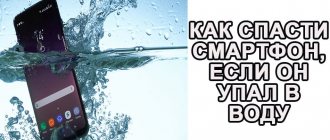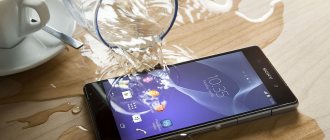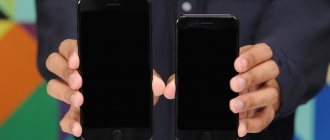Saving drowned phones, according to statistics, is one of the most common problems with which users and owners of various devices turn to service centers. From experience I can say that most often this trouble for some reason happens to iPhone owners. In any case, getting acquainted with a large amount of liquid does not pass without a trace for any phone (now, of course, we are not talking about models with super protection), and if your phone falls into water, the first question that will arise in your mind is what to do, to save a valuable gadget and how to make the “drowned” device work if the phone falls into the water and does not turn on?
I’ll say right away: they won’t give you any guarantees, even at the service center the specialists will dry it out and patch it up, but they will never promise anything. My friend had two phones drowned in the toilet in six months. One disappeared almost without a trace (it works, but confuses all the keys), the second one sat for 2 months, turned on and has been working perfectly for six months now. By the way, not only falling into a container of water can damage your phone, but also heavy rain and splashing waves. Therefore, you should not take risks and talk on the phone, even if you are walking in the rain under an umbrella.
How to tell if your phone is wet
It is easy to determine if water has gotten inside the phone - after that it does not turn on. Press the power button once and it should come out of standby mode. Lack of response indicates the presence of moisture that is interfering with the operation of the device. Even if it turns on, we recommend turning it off - perhaps the water has not yet reached important electronic components. It must be dried before using it.
What happens to your phone when it gets wet?
The first to suffer are the conductive paths on the phone board, which oxidize when exposed to water. Undistilled water contains various salts and impurities - they react with electrochemical corrosion and form the very rust that disables the device.
The battery does not turn off when water gets in – it continues to work. Electric current in the tracks starts the corrosion process. Therefore, the first rule when removing the device from the water is to remove the battery, if possible. If not, then you need to turn off the device. You can turn it on after it has completely dried.
You can't shake the device either. There is a risk that the moisture will spread further. It's a good idea to remove the SIM and memory card tray.
Some people recommend using a vacuum cleaner, but this is dangerous: you can create electrostatics and destroy the board faster than corrosion.
For models marked IP67/68 (especially reliable protection from dust and water) and without visible external damage, drying by any special methods is not necessary: you need to let the device dry in a draft. The water probably didn't get inside.
After using salt water, the device must be carefully rinsed to remove salt - it can clog the connectors and membranes. Then such devices may wheeze, since the microphone will be covered with salt.
What absorbs moisture very well?
Table salt, which everyone has in their home, has a lot of useful features in everyday life, including excellent absorption properties. The product, being absolutely harmless to humans, absorbs moisture well. It is enough to place open containers of salt around the room and it will “pull” liquid out of the air.
Interesting materials:
How many years do Khanty people live? How long is the flight from Minsk to Seychelles? How long does it take to fly from Moscow to the Seychelles? How many liters of strawberries are in 1 kg? How many liters are in 1 Keg? How many liters are in a plastic beer keg? How many people live in Europe? What is the maximum working hours per week? How many months are sick pay paid? How much space does the differential automatic take up?
First actions when the phone fell into the water
A phone that has fallen into water must be immediately removed and turned off. Press the power button, wait until it turns off, remove the battery. Next steps:
- We take out the headphones.
- Remove the tube from the case.
- We take out SIM cards and a memory card.
Removing the battery will slow down oxidative reactions that occur in a humid environment. They damage electronic components and corrode thin conductive traces on the printed circuit board.
Smartphones of recent years use non-removable batteries. You will not be able to remove the battery yourself. The maximum that the user can do is turn off the device with the power button and follow the above steps. We strongly recommend that you take this handset to a service center as soon as possible. There is a very dense arrangement of elements here, it will be difficult to remove water yourself.
Attention - do not remove the phone connected to charging from the water. First, unplug the charger from the outlet, then remove the handset. Performing actions in reverse order will result in an electric shock.
Remove the battery, SIM card and memory card
The next thing to do if the phone has fallen into water is to remove the battery and cards; if there is a case, remove it. A smartphone that is turned on needs to be turned off, although most often it turns off on its own, but you cannot turn it on or press buttons to make sure it is working. It is also better to hurry up when removing the battery, because it is necessary to completely de-energize the device to avoid a short circuit. Remove the cover of the device and take out the battery (if the design allows it), then the memory card and SIM. If any devices were connected to it, they must also be disconnected immediately. If there are plugs on the connectors, it is advisable to leave them open for air circulation.
Features of drying various phone parts
After general drying, moisture may still remain in some elements of the phone. Depending on how and for how long the device fell into water, the likelihood of damage to certain elements changes: display, camera, speaker, etc.
How to dry your phone screen
When the screen gets wet, just wipe it with a dry cloth or a special rag that does not leave streaks.
Between glass and screen
After disassembling and drying the smartphone, problems such as moisture getting under the display and deterioration in the quality of the speaker and microphone may become apparent.
20 shocking historical facts that you definitely weren't taught about in school -
Rules for drying your phone
The most important thing in this matter is time. The faster you get the device out of the water, the higher the chance of it working. Even models with a high level of moisture protection guarantee operation of the device only for up to 30 minutes under water. If a cable was connected to the smartphone, then first disconnect it from the power source, and only then reach for the smartphone.
The second important condition is to turn off the device. You should not leave it on, even if it seems to be working fine. Also, you should not turn it on after a few minutes to check if it works. Moisture in a working smartphone can lead to a short circuit, which will definitely damage it. Remove the battery if possible, SIM card, memory card, case.
How to check a smartphone
Even if the smartphone works fine after drying itself, this does not mean that it will work for a long time. It is possible that some elements have already corroded or there is some water left inside.
Even after successful drying, it is advisable to take the smartphone to a specialist for inspection. Device diagnostics will not be too expensive, and in some service centers it is free.
How to quickly dry your phone
There is simply no universal drying method. It all depends on how badly the gadget was damaged and what elements were flooded. In any case, haste will only make the situation worse. Therefore, you need to dry your smartphone for a long time and carefully.
To speed up the effect, you can choose methods with rice/silica gel and change them as often as possible, every 5-6 hours. This will help reduce drying time.
Absorbent or rice
Rice or a substance that absorbs water is a more effective method to remove moisture particles from the device. To begin with, we remove the excess liquid with a towel and blot thoroughly. It is impossible to remove all the drops with this method, so it is recommended to leave the phone in a bowl of rice. This cereal requires a lot of liquid, so in a few hours it will take away all the remaining moisture.
How to dry your phone at home
There are many options for saving your gadget. Let's look at various ways to dry your phone after it gets into water.
Using a hair dryer or vacuum cleaner
In such situations, many people recommend using a hairdryer as a usual means of drying. However, in the case of electronic devices like a smartphone, it is better not to use a hair dryer. Firstly, air currents can cause liquid to enter other parts where it has not yet been, and secondly, at a close distance, the hot air of a hair dryer can damage some internal components of the smartphone.
It is possible to dry the device with a vacuum cleaner, but this will only work if there is little water ingress; in addition, it will take a very long time to dry.
Is it possible to dry a phone on a battery?
The smartphone can be placed near a heater or radiator to reduce drying time. It is important not to place the device close to the battery, because here the effect on the components will be even stronger than from a hair dryer and you can damage your smartphone. In this case, you still need to wait more than a day for complete drying.
Using the app
After drying out the phone, many users experience muffled sound from the speaker. The Apple Watch has a feature that releases water from the speaker by playing a specific tone. A similar effect can be achieved on a smartphone using the Fix My Speakers website.
Important!
Do this only after it is completely dry.
Drying in rice
The most common remedy used to speed up the drying of the phone is regular rice. It will take at least two days to dry your smartphone this way. Disassemble the smartphone as much as possible and place it in a container with rice. Every 12 hours you need to turn your phone over.
Absorbents
An absorbent is a substance that helps draw and absorb moisture. To use it, you must have a container that can accommodate the product and the phone itself. Drying rules are as follows:
- Rice is the most common absorbent. The device should be placed without the battery and lid in a container with cereal for 2-3 days. The device should be turned over once every 12 hours.
- Using silica gel cat litter. In order to dry the phone, you need to place it in a container with filler for two days. It is important that the product completely covers the phone. From time to time the gadget needs to be turned over.
- Silicone balls for shoes are quite an alternative option to the previous ones. It takes moisture out of your phone in 2 days.
On a note! It is necessary to check the phone every 6 hours and wipe it with a paper towel or napkin, thereby removing moisture from the surface. If the damage is severe, the absorbent can be changed.
Compressed air
The main point of this method is to speed up the drying process. An excellent option would be a cylinder with compressed air inside. This device is most often used to clean hard-to-reach places, computer motherboards and laptops from dust.
To use the cylinder, you must pass air through all possible openings of the gadget - charging connector, speaker, microphone. Particular emphasis should be placed on the charger port, as it is closest to the battery compartment. This will give more space for air to move.
Important! This method is a preventive measure and does not eliminate moisture from the phone as much as possible.
Synthetic dehumidifiers
Various online stores offer a large number of accessories for small electronic devices. Synthetic desiccants are hermetically sealed bags with special granules inside.
The downside of this device is its price category. On average, you will have to pay about 1,200 rubles for a product. Moreover, you will have to order it in advance, “just in case,” since if water gets into the phone and the order takes a long time, it will no longer be possible to save the gadget.
Isopropyl and ethyl alcohols
For many years, these types of liquids have been considered the most accessible and inexpensive means that can be used to clean the insides of radio equipment.
Since the main reason for device failure is corrosion, isopropyl alcohol, which contains chemical elements, can prevent its occurrence by removing moisture at the same time
How to use alcohol:
- pour alcohol liquid into the container and place the phone in it;
- leave the device for half an hour;
- take out the gadget and do not turn it on for 8-10 hours.
If done correctly, this method will help revive the mobile device after it gets wet.
Freeze phone
If water turns into ice, its molecules will have less of a conductive effect due to an increase in the distance between the molecules, which means there is an obstacle to a short circuit.
How to freeze your phone:
- wrap the device in 2-3 layers of paper;
- place it in the freezer for 20 minutes.
After the time has passed, you need to remove the device and try to turn it on. If nothing happens the first time, you need to try turning it on again. Most likely, after several attempts, the phone will work. The main thing is not to keep the gadget in the freezer, otherwise you may get the opposite effect and the situation will worsen.
How to remove water from a speaker
If the user spills water on the phone and liquid gets into the speaker hole, it is recommended to perform similar actions with the device. We remove the battery and dry it naturally, preferably in the sun, use napkins to blot the liquid, wipe with alcohol, and use absorbents. If the device gets very wet, it is better to disassemble it for drying, but if you do not have such skills, contact the service. There is also special smartphone software that reproduces high-frequency sounds by squeezing moisture out of the speaker. For example, on an iPhone, you can use the free Sonic app, which generates sounds.
Ambulance for a drowned man
For starters, don't panic. After all, if the gadget has not been in the water for long (and it is usually removed in the first seconds), the probability of saving it without the intervention of a service center is quite high. The main rule: the faster the rescue operation begins, the greater the chance of the smartphone to survive. So don’t hesitate and do the following as soon as possible:
- Remove the smartphone from the water and turn it off.
- Remove the protective cover (if equipped).
- Remove everything that is possible from the gadget: memory card, SIM card.
And if all the preparatory manipulations have been successfully completed, you can proceed directly to drying.
Normal drying
This method is the simplest, but it is only suitable for “mild” cases. Let's say the smartphone got caught in the rain or was accidentally wetted by a stream from the shower. That is, the wetness was insignificant, and the gadget did not “dive” into the water.
In this case, it is enough to simply wipe the smartphone with paper napkins and leave it in a warm (+40-45℃) place for a day. If it is a battery, then several layers of fabric should be provided between its surface and the gadget, which will prevent the device from overheating.
Alcohol
Another popular method is to fill a drowned gadget with alcohol. The operating principle of this method is similar to the previous one: alcohol also draws out water, while being absolutely safe for contacts and microcircuits.
And there is one “but” here. The alcohol must be alcohol - not vodka or other strong alcoholic drink. Any impurities will only bring the end of the already damaged smartphone closer.
What you should absolutely not do
The first thing you definitely shouldn’t do is check the functionality of the device after a “swim”. It definitely won’t work correctly, but such a test can aggravate the situation “once”, up to a short circuit.
For the same reason, you should never connect the gadget to an electrical outlet.
Some people advise shaking a wet smartphone to quickly get rid of excess moisture. However, this is far from the best solution, because you still won’t be able to shake out what has gotten deep into it, and it’s very possible to distribute water throughout the entire smartphone, which, of course, is extremely undesirable.
There are also advisers who recommend using a hairdryer.
Of course, this is the first thing that comes to mind for many. But it’s better not to put such an idea into practice: you won’t be able to dry the gadget with a hairdryer; the water will only go deeper. In addition, a stream of hot air can melt the plastic parts of the smartphone case and completely ruin wet electronics.
What is prohibited to do
The rules are simple:
- You should not dry your phone in the oven - it will not withstand such heat (the minimum temperature in the oven is about +80 degrees).
- Do not place the handset in a microwave oven.
- Do not wipe the tube with alcohol - it is unlikely to draw out any remaining moisture.
- Do not place the phone on a heating pipe - its temperature may be too high.
Batteries are most afraid of overheating - there is a high probability of explosion.
Is it possible to dry your phone with a hairdryer or vacuum cleaner?
A regular hairdryer will help you dry your phone at home. Set the minimum temperature, direct a stream of air at the device - the moisture will begin to evaporate more intensely. There are also opinions that a hair dryer does not remove moisture, but forces it to penetrate deep into the device, accelerating corrosion.
Before you try to dry your phone with a vacuum cleaner, shake out any large drops of water from it. Place the plastic nozzle on the hose, turn on the vacuum cleaner, and bring the device to the “drowned man”. Air currents will help draw out remaining moisture. Do not touch the nozzle to the gadget to avoid its failure - powerful air currents electrify the hose with the nozzle, causing the accumulation of static electricity. Static can damage electronics.
Prospects
Contact with water is a serious test for any equipment. In drowned smartphones, the sound and display are most often affected.
Sound problems may include the following:
- the occurrence of noises of a different nature: hissing, squealing, wheezing;
- speaker sound disappears;
- no microphone sound.
The following problems may occur with the display:
- the appearance of spots, streaks on the screen;
- partial or complete incapacity of the sensor.
Any of these problems interferes with the normal functioning of the gadget and calls into question its further use. If self-drying does not help (and no one can guarantee that the methods described above will cope with the task 100%), you will have to contact a service center.
And this, as you know, costs a lot of money.
Final steps
When the affected device has gone through all the drying steps, install the battery and return the removed parts, case, and cards to their place.
Turn on and try out all the functions, test the touch screen, headphones, listen to music. Copy the data to the archive.
If the phone does not start, connect it to the charger. If it doesn't start, check the battery - there may be damage.
The best option in case of drowning of the phone is to contact a specialized service center. The technicians will competently carry out all the “resuscitation” actions, and will also fully check the smartphone for functionality.
Time to dry
The hardest part is that the phone cannot be touched for a long period of time. This means you won't be able to use your smartphone! If you have another phone you can borrow, just make sure the SIM card is completely dry and insert it into the working handset. Otherwise, just use public phones or smoke bombs.
Nowadays it is a very common practice to cover the phone with bags of rice and let it lick for about 2-3 days.
But why rice? Mainly because it is in every home. The idea is that rice is very good at absorbing moisture, which makes the environment around the phone drier and therefore helps dry the device faster. But there are alternatives that may be better.
Among the best options are silica gel packs , which are those little packets you often find in a shoe or electronics box.
Functionality check
I drowned the phone in water - dry it for 24 hours without turning it on. This rule will help avoid corrosion. After a day, install the battery and press the power button. If the phone does not turn on, take it to service. Explain to the repairman that it is wet. Be sure to indicate the type of liquid - for example, salt water is more aggressive than fresh water. And the sweet one will require complete disassembly of the device to get rid of any remaining sugar.
How to dry the phone is up to the owner to decide. We recommend sending it to a service center as soon as possible. Here the device will be disassembled and thoroughly dried, removing any remaining moisture. Specialists will also replace failed components. Drying at home can only worsen the situation - especially if it is a smartphone with a non-removable battery.
Contacting service
It is possible that if the smartphone was slightly discharged when it fell into liquid, the battery is discharged and you need to charge the phone. If the smartphone still does not turn on, then the internal components are most likely damaged. It would be best to contact a service center.
If you find moisture trapped under the screen or camera glass, then also contact the service center; you should not try to get to these parts of the smartphone by disassembling it or heating it with a battery, hair dryer, etc. Rice and silica gel will also not be able to help here, if in general the device is working normally.
The worst situation
Electric shock Imagine that your phone is charging, that is, connected to the electrical network, and at that very moment, a mug of tea, coffee or any other drink is accidentally poured onto it.
The first, almost instinctive movement will be to grab the phone and wipe all the moisture off it. This should not be done under any circumstances. You could simply get electrocuted. If immediately after the incident the traffic jams did not go out and the lights did not go out in the apartment, this does not mean that the danger, especially for you, has passed. The first step is to unplug the charger from the network, or turn off the electricity altogether, and only then take any action to save the phone itself.
Paper towel
If the device gets wet from liquid, it is better to dry it with a cotton towel. Paper tends to absorb water, swell and break apart into particles that fall into the openings of the housing and penetrate inside. When you first start the smartphone system after an accident, particles of paper towel will cause the contacts to short out or burn out.
A method that will help remove traces of mineral deposits or water stains
If after drying your phone the liquid left traces of mineral deposits or wet water stains, you can try cleaning these residues with 99% isopropyl alcohol. The latter leaves no traces after drying, dries quickly, and perfectly removes mineral deposits and dirt residues.
Use 99% isopropyl alcohol for cleaning
Use this method as a radical one, since there is disagreement among experts about the harmfulness of alcohol baths for a mobile device.
Before soaking, we recommend removing all removable parts from your phone and wiping them with a clean cloth dampened with 99% isopropyl alcohol. Then set these parts aside and let them dry.
What do I need to do? Find a container that allows you to completely immerse your phone. Pour in enough 99% isopropyl alcohol to completely cover your phone. Soak your phone in alcohol for 15 minutes. Then, without removing it from the liquid, shake it slightly. Wait 10-15 minutes and then shake your phone again.
Immerse your phone in alcohol
After about an hour, take a look at the alcohol your phone is in. If it looks dirty, remove the phone from the alcohol and let the gadget dry a little. Remove most of the alcohol from the phone, empty the dirty alcohol from the container, fill it with new clean isopropyl alcohol, and soak the phone in there for another hour. We do not recommend rinsing the container with water during cleaning, otherwise you will have to dry it completely before adding a second dose of alcohol.
The time it takes to immerse the phone in alcohol is several hours.
After this time has elapsed, remove the phone from the alcohol container, drain the alcohol, and wipe the outer surface of the screen with a clean, dry cloth as best as possible.
Wipe the surface of the mobile phone with a cloth
Isopropyl alcohol should dry relatively quickly. However, we recommend leaving your phone to dry for 24 hours or at least overnight.
In the case of a positive scenario, your phone will turn on and return to 100% functionality.
The main problems when water gets into a smartphone
The most difficult problem is the shorting of contacts, which will then need to be changed. If moisture gets on the modules in small quantities, then there is a chance that after drying it will function normally. If you tried to turn it on wet, then the risk of burnout increases by 96%.
It is also strictly forbidden to charge a wet or damp device. The risk ranges from short circuit to fire.
After contact with moisture, the phone may function normally, but some of its elements often stop working. The most vulnerable are the speaker, microphone and battery. Almost always, after serious wetness, they require cleaning or replacement.
Time stands still as you see your phone falling straight into the water. It doesn’t matter if it’s a pool or a toilet, you just understand that it’s probably going to end.
Still, it's a high-tech device that probably costs several hundred dollars, and there's a very good chance it won't work if it gets wet. Unless of course you have one of those amazing waterproof smartphones like the LG G6 or Samsung Galaxy S8.
Attention! You should definitely check out the list of the best Android smartphones (2018) with their specifications and prices.










